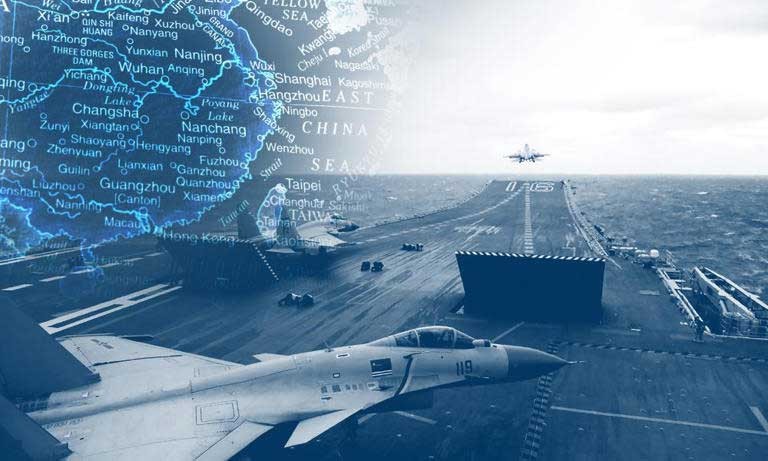The Guardian
China’s war chest: Beijing’s ‘great wall of steel’ faces obstacles to military supremacy
Story by Amy Hawkins senior China correspondent • 15-5-2023
Taiwan’s foreign minister says he is preparing for conflict with China. In an interview this month, Joseph Wu said that “we are taking the Chinese military threat very seriously” and named 2027 as the year to be concerned about.
As relations between China and the US spiral ever lower, many analysts are increasingly worried that a conflict could be on the horizon and that the relationship between Taiwan and the US will be an important factor in influencing if and when China attempts to annex the self-governing island.
The CIA believes that China’s leader, Xi Jinping, has told the military to be ready to invade Taiwan by 2027. At China’s annual parliamentary meetings in March, Xi said he would build China’s military into a “great wall of steel”, but stressed the need for a “peaceful development of cross-strait relations”.
China already has the world’s largest armed forces, with about 2 million active personnel. Its navy is also the world’s biggest, with an estimated 355 active vessels compared with the US’s 296. In 2021, Vice Adm Kay-Achim Schonbach, then the commander of Germany’s navy, said China was expanding its navy by the equivalent of France’s entire navy every four years.
An invasion of Taiwan would probably rely on a naval encirclement of the island, so China’s maritime capabilities will be of particular importance to those trying to glean how capable the People’s Liberation Army (PLA) is of achieving its aim.
On 7 April the Pentagon announced a $1.7bn deal with Boeing for 400 anti-ship Harpoon missiles. The buyer is reportedly Taiwan, although this has not been officially confirmed.
Part of China’s push to modernise its armed forces has been a strategy of pursuing “military-civil fusion”, with the aim of developing the PLA into a “world-class military”. The government encourages private businesses to support the development of military technology, in everything from AI to nuclear technology to drones.
This strategy is evident in China’s shipbuilding industry. The China Shipbuilding Group Corporation accounts for a fifth of global ship production and also produces vessels for China’s navy. Such a high level of integration is “relatively uncommon”, according to the Centre for Strategic and International Studies (CSIS), a thinktank.
It also hampers the ability of outside countries to understand or limit China’s military development.
“With little transparency and differentiation between military and civilian operations, it is impossible to determine the extent to which foreign ship orders may be helping to lower the costs” of the PLA’s naval modernisation, CSIS notes.
The PLA navy has also used civilian ferries to conduct military exercises. This hampers the ability of US and Taiwanese intelligence to detect abnormal activity.
Another trend of the past decade has been China’s efforts to become self-sufficient in advanced technology, particularly arms manufacturing. After concerted efforts over a number of years to advance its technological capabilities, China now produces more than 90% of its weaponry domestically, according to the Stockholm International Peace Research Institute, a thinktank.
China’s war chest: Beijing’s ‘great wall of steel’ faces obstacles to military supremacy
Story by Amy Hawkins senior China correspondent • 15-5-2023
Taiwan’s foreign minister says he is preparing for conflict with China. In an interview this month, Joseph Wu said that “we are taking the Chinese military threat very seriously” and named 2027 as the year to be concerned about.
As relations between China and the US spiral ever lower, many analysts are increasingly worried that a conflict could be on the horizon and that the relationship between Taiwan and the US will be an important factor in influencing if and when China attempts to annex the self-governing island.
The CIA believes that China’s leader, Xi Jinping, has told the military to be ready to invade Taiwan by 2027. At China’s annual parliamentary meetings in March, Xi said he would build China’s military into a “great wall of steel”, but stressed the need for a “peaceful development of cross-strait relations”.
China already has the world’s largest armed forces, with about 2 million active personnel. Its navy is also the world’s biggest, with an estimated 355 active vessels compared with the US’s 296. In 2021, Vice Adm Kay-Achim Schonbach, then the commander of Germany’s navy, said China was expanding its navy by the equivalent of France’s entire navy every four years.
An invasion of Taiwan would probably rely on a naval encirclement of the island, so China’s maritime capabilities will be of particular importance to those trying to glean how capable the People’s Liberation Army (PLA) is of achieving its aim.
On 7 April the Pentagon announced a $1.7bn deal with Boeing for 400 anti-ship Harpoon missiles. The buyer is reportedly Taiwan, although this has not been officially confirmed.
Part of China’s push to modernise its armed forces has been a strategy of pursuing “military-civil fusion”, with the aim of developing the PLA into a “world-class military”. The government encourages private businesses to support the development of military technology, in everything from AI to nuclear technology to drones.
This strategy is evident in China’s shipbuilding industry. The China Shipbuilding Group Corporation accounts for a fifth of global ship production and also produces vessels for China’s navy. Such a high level of integration is “relatively uncommon”, according to the Centre for Strategic and International Studies (CSIS), a thinktank.
It also hampers the ability of outside countries to understand or limit China’s military development.
“With little transparency and differentiation between military and civilian operations, it is impossible to determine the extent to which foreign ship orders may be helping to lower the costs” of the PLA’s naval modernisation, CSIS notes.
The PLA navy has also used civilian ferries to conduct military exercises. This hampers the ability of US and Taiwanese intelligence to detect abnormal activity.
Another trend of the past decade has been China’s efforts to become self-sufficient in advanced technology, particularly arms manufacturing. After concerted efforts over a number of years to advance its technological capabilities, China now produces more than 90% of its weaponry domestically, according to the Stockholm International Peace Research Institute, a thinktank.
1 yr. ago


